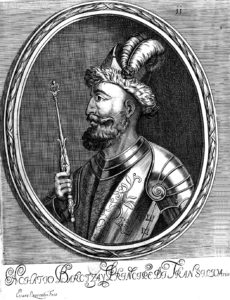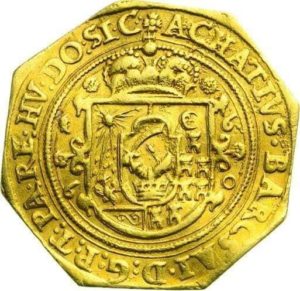Prince Barcsay Ákos of Transylvania (1610-1661)

Barcsay Ákos was born in Hunyad County in Transylvania, he came from a modest noble family. His family might have come from Croatia, as one of his ancestors was a Bán (Duke) of Croatia in 1226. However, the old nest of the family was in Nagybarcsa, in Hunyad County, Transylvania. Barcsay Ákos was born there, he was a Calvinist. His father was Barcsay Sándor, his mother was Palatics Erzsébet. He grew up at the court of Prince Bethlen Gábor. (Please note that I use the oriental name order for Hungarians, where the surname comes first).

We know that Prince Rákóczi György I. appreciated his talented and educated way of thinking. He once said about him: “His mind is marvelous, you can never find out how he thinks”. Prince Rákóczi György I often gave him diplomatic missions, and Barcsay carried them out flawlessly. The prince rewarded him for his services and his career rose rapidly. Eventually, he became the Chief Comes of Hunyad County and the Captain of the Déva Castle. Barcsay Ákos’s first wife was Szalánczy Erzsébet, and after her death, he married Bánffy Izabella in 1660.
Prince Rákóczi György II also held him in high esteem. No wonder, because it was Barcsay’s diplomatic skills that helped him to get his throne confirmed by the Sultan in Istanbul. Before Rákóczi launched his infamous campaign to seize the Polish throne in 1657, he appointed Barcsay, Serédy, and Rhédey to govern Transylvania on his behalf. When Serédy died, Rhédey resigned and Barcsay remained in this position alone. It was at this time that the enmity between him and Lady Báthory Zsófia began over financial issues.

The Ottomans were angry with Rákóczi and demanded his removal from power. The Transylvanian estates had to choose a new prince, but at first, they thought that Barcsay was not so high-born, so they chose Rhédey Ferenc. However, Rhédey handed over the power to Barcsay in 1658. The punitive campaign of Pasha Köprülü soon reached Transylvania, and the estates of the country sent envoys to the Grand Vizier. (In the Turkish language, the high military leader was called “vizir-i-Azam”). Barcsay was among the delegates, and when he received them in his camp, he appointed him Prince of Transylvania. Barcsay was not happy with the job, but he had to accept it.

He had to promise to pay immense taxes if he wanted to get rid of the Ottoman troops. The amount of the tax was 40,000 thalers and he had to promise 500,000 thalers as “military compensation”. He also had to give up the castles of Karánsebes and Lugos. For this, many contemporaries called him a traitor. Fortunately, the money decided the issue and the Turks soon left Transylvania (for the time being).

Barcsay Ákos, Prince of Transylvania
On October 11, 1658, the nobility officially raised Barcsay to the throne on the Diet of Segesvár. Rákóczi, however, could not accept this and plotted against Barcsay in Várad. But when it became clear that the Turks were planning to attack the castle, he made a deal with the new prince, apparently resigned, and retreated to his estates. Here, instead, he continued to arm himself, which threatened another Turkish attack.

When Barcsay received the news about the gathering soldiers of Prince Rákóczi György II, that they were preparing to fight him, he went to the castle of Temesvár (Timisoara). Temesvár was held by the Ottomans at that time, and Barcsay visited Csengizáde Ali, the Pasha of Temesvár because he wanted to prevent any kind of bloodshed between his Hungarian supporters and Rákóczi’s Hungarians. As it was, Transylvania had been destroyed for the second time by the Tartars; important fortresses fell or were ceded to the enemy, and the country was devastated. Although Rákóczi should have been blamed, many Transylvanians blamed Barcsay for the devastating wars. He also lost his reputation among the Turks.

During his absence, Rákóczi invaded Transylvania, and in fear of him, the Marosvásárhely Diet restored him to power on September 29, 1659. As it turned out, Barcsay could not avoid bloodshed, so he retreated to Szeben. Soon, the Pasha of Buda, Sheydi Ahmed finally came to his aid and defeated Rákóczi’s army at Zajkány on November 22 and at Torda. Rákóczi then fled Transylvania, but soon returned. When the pasha left Transylvania in December, Rákóczi began the siege of Szeben (Sibiu).
He continued to fight for his throne, bringing even more suffering to the inhabitants of the once prosperous “fairy garden” of Europe. It was the time when the Hungarian population between the area of Gyulafehérvár (Alba Iulia) and Arad was literally wiped out. You can read more about Rákóczi’s struggle in 1658 here:
Barcsay withstood the attack in Szeben for months, but in the spring Rákóczi was forced to abandon the operation because Sheydi Ahmed’s army was approaching again. Barcsay had to go to the castle of Szeben.
Rákóczi’s defeat at Zajkány, near Déva Castle
It happened on 22 November 1659, when Pasha Szejdi Achmed defeated Prince Rákóczi at Zajkány. Prince Rákóczi had already been forced to resign and re-elected several times. He was re-elected in September 1659 and immediately launched a campaign against his rival, Barcsay Ákos, who was supported and appointed by the Turks. In order to defeat him, Rákóczi formed an alliance with Voivode Mihnea of Wallachia and their combined forces attacked Moldavia and after driving out its ruler, they put their man, Konstantin Serban, on the throne for a short time.

It was Pasha Szejdi Achmed of Buda Castle who came to Barcsay’s aid. The Turks were approaching Transylvania from Temesvár/Timisoara, so Rákóczi concentrated his forces around Déva Castle at the Vaskapu/Iron Gate. However, Achmed Szejdi outwitted him by not leading his troops straight into the pass, but taking a detour to the north and crossing the mountains. There he met the weaker part of Rákóczi’s army, his right wing. Thus the Turks and Barcsay won the day at Zajkány on 22 November 1659.
Rákóczi had to retreat to avoid being surrounded. His situation was made worse by the defeat of his two allies: Voivode Mihnea was defeated by the Pasha of Silistra and Voivode Constantine was crushed by the army of the Crimean Tatar Khan. The Voivode of Moldavia was forced to flee.
Rákóczi gathered his remaining troops in the area of Nagyszeben (Sibiu), while the Turkish raiders were destroying Bihar County. The prince hurried there, but he was stopped by Pasha Achmed’s army in the town of Szászfenes and suffered his final defeat on 22 May 1660. The prince died of his wounds a few days later. Here are the details of the battle:

After the death of Rákóczi, the Pasha of Temesvár took Barcsay into custody but gave him all the respect and comfort. The only way he could get out of the friendly prison was to pay a part of the high taxes demanded by the Turks. In the meantime, the Turks took Várad castle, though. When Barcsay was released, Kemény János also returned from the Crimean captivity. Kemény usurped the Transylvanian throne, hoping for the military help of the Habsburgs. Kemény also considered Barcsay as his personal enemy and started to exterminate his family members. Barcsay’s brother, Gáspár, was defeated by Kemény in November and soon afterward he was killed. You can read more about his actions and his death here:
Barcsay preferred peace and resigned from power on December 31, 1660. He wanted to avoid a civil war and had never wanted power in the first place. However, Kemény did not want to see a potential rival alive and had him killed in the first half of July 1661. According to Krausz, a contemporary Saxon chronicler, Prince Barcsay Ákos, one of the most educated people of his time, was executed in this way:

The death of Barcsay Ákos
When Barcsay was traveling in a wagon, he and his men were ambushed between the villages of Kosmann (Kozmatelek) and Répa. Barcsay was shot, his true friend and half-brother Budai Zsigmond was beheaded, and his servant Szövérdi János was slaughtered. The bodies were buried by the local peasants next to the village pillory. Krausz heard that Doboli István, another servant of Barcsay, heard about the crime and hurried there to get the body of the lord. He even took a white lint from Gyulafehérvár with him. When he found the body, he had it buried in the church of Kozmatelek. Later Prince Kemény János had Doboli hanged in the castle of Fogaras as a punishment.

At the beginning of the 20th century, a monument was erected to commemorate the death of the prince. It was built in 1906 by Spáda János, a bricklayer from Kolozsvár. Two skeletons were found during the first phase of the work. They chose this place because in 1830 there was a wooden cross with an inscription in Romanian on it: it was the burial place of Barcsay Ákos. It is believed that the locals have always remembered the resting place of the murdered people.
The position of the skeletons suggested a hasty burial, one of them even had a fetter. If the body of the prince is really in the church, the man tied up must have been Budai Zsigmond, because another contemporary source, Szalárdi János, mentioned that Barcsai and Budai were tied up. One of the dead men had a severe neck injury, while the other had saber cuts on his skull. The remains of the pillory were found under the bodies. Barcsay’s grave is said to be in the church of Kozmatelke, but we do not know its exact location…

Sources: Szibler Gábor, and Fontes Historiae http://fonteshungariae.blogspot.com/2010/12/barcsai-akos.html
and Márk Éva https://korok.webnode.hu/products/barcsay-akos-es-kemeny-janos-fejedelmek/
and Wikipedia has an excellent article about Barcsay in the Hungarian language…
Dear Readers, I can only make this content available through small donations or by selling my books or T-shirts.
If you like my writings, please feel free to support me with a coffee here:
You can check out my books on Amazon or Draft2Digital, they are available in hardcover, paperback, or ebook:
https://www.amazon.com/dp/198020490X
or at https://books2read.com/b/boYd81


My work can also be followed and supported on Patreon: Become a Patron!http://Become a Patron!


[wpedon id=”9140″]

https://hungarianottomanwars.myspreadshop.com/all


